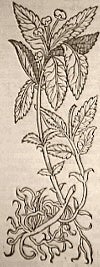
 |
[De materia medica. Latin]
Pedanii Dioscoridis Anazarbei De medicinali materia libri sex.
Ionne Ruellio Suessioni interprete. Additis etiam annotationibus sive scholiis brevissimis quidem, quae tamen de medicinali materia omnem controversiam facile tollant per Gualtherum H. Ryff. Accessere in eundem autorem Schola nova, cum nomenclaturis Graecis, Latinis, Hebraicis, & Germanicis, Ioanne Lonicero autore. Francoforti: Apud Chr. Egenolphum, 1543. The Scholia nova of Lonicerus has separate t.p. with imprint: Marpurgi: Christianus Aegenolphus excudebat. Translated from the Greek; this translation first published 1516. The Scholia [as printed on rec-see other side]. Date of main work from BM STC German, 1455-1600. References: BM STC German, 1455-1600. Includes indexes.
This work is a translation of Dioscorides, who was the most authoritative writer in botany for 16 centuries. The first folio edition was published in 1516. Dioscorides, born in a small town near Tarsus, was a product of the classical world of Greece and Rome. He flourished during the time of Nero. Travelling widely, he studied plant life wherever he journeyed, eventually writing what became the most influential herbal ever written. For over 1,500 years his work was considered the final authority on the pharmaceutical use of herbs and plants. The modern science of pharmacology can be traced to Dioscorides' efforts to systematize the knowledge of material medicine. His work describes roughly 500 plants, but as no contemporary version survives, our study must be based on later printed editions. Early illustrations were decorative rather than realistic. It is important to remember that this herbal, as well as many others in this collection, pre-dates the current Linnean botanical classification scheme, which further complicates any comparison with modern plants. Once this work was printed, pirated editions and translations appeared everywhere, usually undated, with sources not acknowledged. Dioscorides' studies, which served as the basis for many of the herbals described in this catalog, have retained popularity throughout the centuries. A reprint of his work was issued in Barcelona as recently as 1970. When Dioscorides described the Nasturtium (nose-twister) he did not categorize it as an ornamental flower, but as a kind of cress, from the mustard family. The seeds were recommended as an aphrodisiac, and were also used in potions to drive out worms and to stop hair from falling out.
Subjects: : Botany--Pre-Linnean; Medicine; Medicinal plants; Medicine, Greek and Roman.
PAT-112